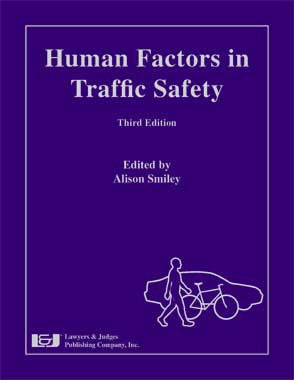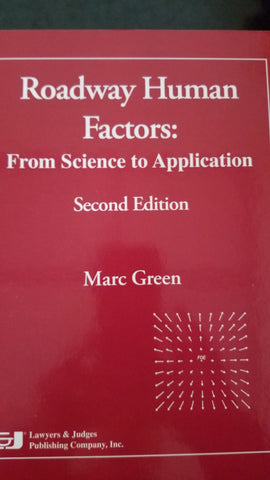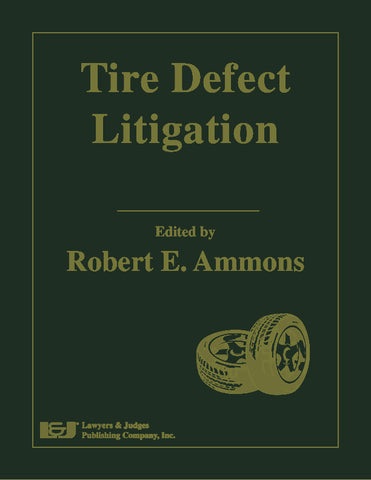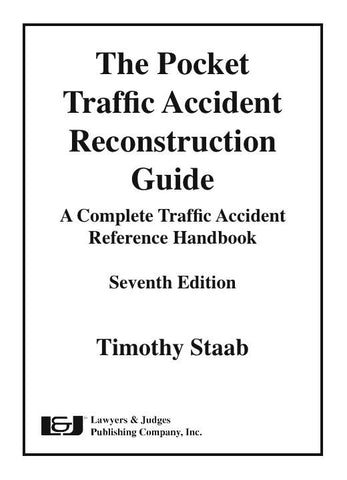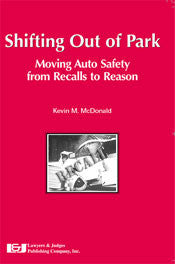
Shifting Out of Park
- Author: Kevin M. McDonald
- ISBN-10: 1-933264-16-0
- ISBN-13: 978-1-933264-16-5
- Copyright Date Ed: September 1, 2006
- Pages: 336 pages
- Binding Information: Softbound
- Size: 6 x 9 Inches (US)
Shifting Out of Park: Moving Auto Safety from Recalls to Reason is an in-depth look at the automobile recall process. Vehicle safety and reliability is considered to be better than it has ever been, yet the National Highway Traffic Safety Administration (NHTSA) continues to issue as many as 30 million vehicle recalls per year. A paradox perhaps. This book discusses the history of the recall process and the reasons NHTSA devotes a high percentage of its attention to this matter, with more vehicles recalled than sold each year. Yet it administers this program in a costly and rather ineffective manner for all parties involved. First of all, compliance is difficult to enforce since up to a quarter of the recall notices, on vehicles, are not attended to by the owners. Second, the cost of recalls is very high in terms of cost per vehicle. NHTSA estimates that recalls cost automakers about $100 per vehicle per recall. But that’s only part of the costs, namely, parts and labor. This estimate fails to consider costs such as engineering, tooling, and producing the replacement parts. Worse, it ignores indirect costs, which dwarf direct costs and include the loss of market capitalization, market share, and brand damage as a result of a recall. Third, there is a cost to those who do take their vehicles in to fix the recall. Having to fix the recall causes extra risk of accidents due to additional travel, loss of time and productivity due to bringing the vehicle to the dealer, and cost of fuel needed to make the additional trips.
It is possible that the recalls may risk more lives than they save. It is estimated that the additional travel, caused by owners fixing the recalls, causes three to four deaths a year, let alone many injury and non-injury causing accidents. The program is expensive in more ways than just monetarily, and the question of whether or not the safety benefits of the recall program outweigh the costs has been asked, but remains unanswered. The Federal Government refuses to study the issue and claims that the small number of actual facts and the large number of unknown factors make it next to impossible to evaluate the program.
With this book Dr. Kevin McDonald evaluates the recall process and starts a discussion on how it might be changed for the better. He discusses the three components of traffic safety in order of importance and how they contribute to automobile accidents: driver safety, roadway safety, and vehicle safety. He also discusses automobile regulation and the three steps that must occur for regulation to take place: public awareness and demand for action, legislation, and continuing administration. He unravels the legislation and litigation that started in 1966 with the creation of NHTSA and continues today, including an exhaustive analysis of the TREAD Act, passed in the wake of the Ford-Firestone recall. Separate chapters are devoted to how the courts have handled recall orders and the recent trend to have courts, not NHTSA, order recalls and how they affect the recall process. Dr. McDonald then compares the current American recall process and its history with the recall processes of several foreign countries with excellent auto safety histories. He gives suggestions for improvement that will allow the recall process to save money and better serve the American public. The book is clear and to the point and will serve as a descriptive resource for all parties, from judges and lawyers to auto designers and mechanics to concerned citizens, interested in traffic safety in America and the auto recall process.
This book is also available as an eBook. Click here to purchase and download:
Topics Include:
- Overview of the recall process
- Research in auto and traffic safety
- Human factors in auto and traffic safety
- Regulation of the recall
- Legislation of the recall
- Litigation of the recall
- Judicial review of the recall
- Transportation Recall Enhancement, Accountability and Documentation ("TREAD") Act
- Comparisons of NHTSA with other American agencies such as EPA, CPSC, FDA and USDA
- Comparison of US regulations with regulations in Australia, Canada, and Germany
- Rethinking the recall process - suggestions for improvement
Table of Contents
Chapter 1: Introduction
1.1 Record Recalls
1.2 Unclear Causes
1.3 Clear Effects
1.4 Overview
Chapter 2: Who’s to Blame? A Reality Check
2.1 A Global Epidemic
2.2 An American Epidemic
2.3 From Causes to Crashes: Clarifying Important Concepts
2.4 A Word about Research
A. Indiana study
B. 100-Car Naturalistic Driving Study
2.5 Human Factors
A. Speedsters and drinkers
B. Hang up the phone—and other distractions
C. Teenage wasteland
2.6 The Regulatory Landscape
2.7 Enter the Lawyers
2.8 Conclusion
Chapter 3: Regulating the Recall
3.1 Nader’s Raiders: The End of the Road for Detroit
3.2 The Safety Act
3.3 The Alphabet Soup Years: 1966–1974
3.4 Time to Shift Gears: 1974
3.5 Three Free R’s: Repair, Replace, Repurchase
3.6 It’s in the (First-Class) Mail
3.7 See You in Court
3.8 Summary of the 1974 Amendments
3.9 ODI
3.10 Oversee Recalls
Chapter 4: Litigating the Recall, Part I
4.1 Introduction
4.2 Safety Act’s Definition
4.3 Wheels
4.4 Engine Mounts
4.5 Pitman Arms
4.6 Quadrajet Carburetors
4.7 Seat Back Bracket
4.8 Windshield Wipers
4.9 Rust
4.10 X-Cars
4.11 Flashers
4.12 Seat Belt Anchorages
4.13 Impact on Academics: A Word on Ossification
4.14 Practical Impact on Manufacturers
4.15 Impact on Safety Act
4.16 Summary
Chapter 5: Legislating the Recall: TREAD
5.1 Background
5.2 Congressional Action
5.3 Impact of the Ford-Firestone Recall
A. Financial impact
B. Federal criminal indictments
C. State investigations
D. International consequences
E. Severed relations
F. Summary
5.4 TREAD
A. Foreign recalls and safety campaigns
B. Early warning reporting
C. Interpretations of Final Rule
5.5 Reporting on Sale or Lease of Defective or Non-compliant Tire
5.6 Accelerated Recall Remedy
5.7 Increased Penalties
A. Civil penalties
B. Criminal penalties
5.8 Postscript and Portents
Chapter 6: Litigating the Recall, Part II: Undermining NHTSA’s Recall Authority
6.1 Preemption 101
A. The doctrine of express preemption
B. The doctrine of implied preemption
C. The doctrine of conflict preemption
6.2 National Traffic and Motor Vehicle Safety Act
A. Notification and remedy duty
B. Preemption and saving clauses
6.3 NHTSA Advisory Opinions on Safety Act Preemption
6.4 Cases Deciding the Preemptive Effect of the Safety Act’s Recall Provisions
A. Federal court cases
B. State court cases
6.5 Analysis
A. Express preemption of automotive recalls
B. Implied preemption of automotive recalls
C. Conflict preemption of automotive recalls
6.6 Conclusion
Chapter 7: Learning From Ourselves … and Others
Part One
7.1 EPA
A. Reporting requirements
B. Recall remedy
C. Recall monitoring and performance
D. Civil penalties
E. Preemption
7.2 CARB
7.3 CPSC
A. Reporting requirements
B. Recall remedy
C. Public notification and remedy campaign
D. Penalties
7.4 FDA and USDA
A. Reporting and recall requirements
B. Public notification and remedy campaign
C. Recall monitoring and performance
D. Summary
Part Two
7.5 Australia
A. Reporting requirements
B. Recall remedy and monitoring
7.6 Germany
A. Reporting requirements
B. Recall remedy
C. Recall monitoring and performance
7.7 Canada
A. Definition of safety-related defect
B. Reporting requirements
C. Civil penalties
Chapter 8: Recall the Recall
8.1 Rethinking the Recall
8.2 Manufacturers: Fight for Your Right!
8.3 Stop Bullshitting—Focus on the Driver, Not the Car
8.4 Let’s Talk About Cost
A. The need for cost-benefit in recalls
B. How to conduct a cost-benefit analysis in recalls
8.5 Increase the Recall Response Rates
A. Speak (plain) English
B. Hold out the cash carrot
C. Amend the National Driver Register
D. Deal with dealers
E. Hold insurers accountable
F. Other ways to increase response rates
8.6 Other Changes
A. Defend the territory
B. Allow for flexible solutions
C. Plugging gaps in Safety Act for used cars
8.7 Summary

